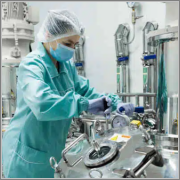
|
시장보고서
상품코드
1345471
세계의 바이오프로세스 시장과 예측(2023년)Bioprocessing Markets and Forecast, 2023 |
||||||
바이오프로세스는 세포, 세포 성분, 바이러스, 생물체 전체와 같은 생물학적 시스템을 이용하여 상업적 제품을 생산합니다. 이 프로세스는 업스트림 바이오프로세스와 하류 바이오프로세스의 두 가지 주요 단계로 구성됩니다. 업스트림 공정에서는 원하는 세포주를 분리하고 배양하여 최종 제품에 필요한 양으로 확장합니다. 이후 세포는 바이오리액터를 통해 채취되는데, 이 바이오리액터는 생물의 복잡성과 양에 따라 일회용 또는 기존형 중 하나를 선택할 수 있습니다. 다운스트림 공정은 생산의 후기 단계로, 업스트림 공정의 마지막에 채취한 세포 및 기타 생물을 정제하여 엄격한 안전 및 품질 기준을 충족하는 최종 제품을 만드는 단계입니다. 이 단계에서는 일반적으로 여과, 농축, 크로마토그래피와 같은 기술이 채택됩니다.
생체 세포에서 생성되는 매우 복잡한 치료용 분자인 바이오의약품은 향후 5년간 저분자 의약품의 매출을 크게 추월할 것으로 예상되고 있습니다. 생물학적 제제에는 백신, 혈액 성분, 유전자 치료제, 재조합 치료용 단백질, 인터루킨 등 다양한 제품이 포함됩니다. 이러한 변화의 배경에는 생물학적 제제의 승인이 증가하고 있으며, 단일 클론 항체(mAb)와 같은 더 복잡한 약물 분자의 생산에 초점을 맞추고 있습니다. 또한 특허 받은 고분자 치료제의 높은 비용에 대응하기 위해 바이오시밀러에 대한 수요가 증가하고 있으며, 향후 5년간 폭발적인 성장이 예상됩니다.
COVID-19 팬데믹으로 인해 개발 일정이 빨라졌고, 초기 발견부터 임상시험 승인까지 3-6개월로 단축된 사례도 있으며, 중화항체(neutralizing mAbs)는 14개월 만에 긴급사용승인을 받았습니다. 또한 치료 목적으로 세계에서 수천 킬로그램의 대량 생산이 신속하게 이루어졌습니다. 이러한 성과는 이 분야의 놀라운 기술적 진보를 잘 보여주고 있습니다. 생물학적 제제 개발에서 달성한 전례 없는 속도는 업계를 변화시켰고, 증가하는 수요를 충족시키면서 제조 비용을 절감할 수 있도록 더욱 강화할 수 있는 길을 열어주었습니다. 앞으로의 성장은 연속 공정, 일회용 시스템, AI 툴와 결합된 첨단 디지털화 및 자동화를 채택하는 새로운 소규모 시설의 채택으로 촉진될 것으로 예상됩니다. 이러한 기술 혁신은 장기적으로 산업의 궤도를 형성할 것으로 예상됩니다.
바이오프로세스 시장에 대해 조사했으며, 제품 유형별, 지역별 동향, 참여하는 기업에 대해 정리하여 전해드립니다.
목차
- 기존 바이오리액터
- 일회용·바이오리액터
- 세포배양 배지와 보충제
- 여과와 농축
- 프로세스 크로마토그래피
- 랩 기기
- 최근 사업 활동과 시장 개척
- 3M
- Agilent
- Applikon Biotechnology
- AsahiKASEI
- Astrea Bioseparations
- Avantor
- Bio-Rad
- Corning
- Cytiva
- Daicel/Chiral Technologies
- Daiso
- Eppendorf
- Infors HT
- MilliporeSigma(Merck)
- Phenomenex
- Pierre Guerin
- Repligen
- Sartorius
- Thermo Fisher
- Tosoh
- WR Grace
BIOPROCESSING INSTRUMENTATION MARKET ANALYSIS
Bioprocessing involves utilizing biological systems, such as cells, cell components, viruses, or entire organisms to produce commercial products. This process consists of two main stages: upstream bioprocessing and downstream bioprocessing. In the upstream segment, the target cell line is isolated, cultured, and scaled up to the desired volume for the final product. The cells are then harvested using bioreactors, which can be either single-use or conventional, depending on the complexity and volume of the organism. The downstream segment involves the later stages of production and involves purifying cells or other organisms collected at the end of the upstream stage to create a final product that meets stringent safety and quality standards. Techniques such as filtration, concentration and chromatography are commonly employed at this stage.
Biologics, the highly complex therapeutic molecules produced by living cells, are expected to significantly overtake small molecules sales over the next five years. Biologics encompass a wide range of products, including vaccines, blood components, gene therapies, recombinant therapeutic proteins, interleukins and more. This shift is driven by the increasing approval of biologics and a focus on manufacturing more intricate drug molecules such as monoclonal antibodies (mAb). Additionally, there is a growing demand for biosimilars to address the high cost of patented large molecule therapies, which are poised to witness explosive growth over the next five years.
The COVID-19 pandemic expedited development timelines, with initial discovery to investigational new drug processes shortened to 3-6 months in some cases, and neutralizing mAbs obtained emergency use authorization within 14 months. Large-scale manufacturing of thousands of kilograms for therapeutic purposes worldwide quickly followed. These achievements highlight the remarkable technological advances in the field. The unprecedented speed achieved in biologics development has transformed the industry and paved the way for further enhancements in reducing manufacturing costs while meeting rising demands. Future growth will be fueled by the adoption of new, smaller facilities that employ continuous processes, single-use systems and sophisticated digitalization and automation coupled with AI tools. These innovations are expected to shape the industry's trajectory in the long term.
SDi's “2023 Bioprocess Instrumentation Market ” observes the market dynamics and specific trends influencing the industry and analyzes their effect on sales growth for instruments and other products employed in bioprocessing. As the leading provider of market research on analytical instrumentation, SDi has crafted this report to evaluate and explain what is currently driving this important market. The bioprocessing instrument market in this report includes bioreactors, cell culture media & supplements, and chromatography. These instruments are categorized into six different technologies that represent the overall market covered in this report.
Report Overview:
Market demand segmented by product type and region along with yearly market forecasts through 2027. The market estimates have been newly updated with 2022 as the base year and estimates are provided for the following techniques:
- 1. Conventional Bioreactors
- 2. Single-Use Bioreactors
- 3. Cell Culture Media & Supplements
- 4. Filtration & Concentration
- 5. Process Chromatography
- 6. Lab Equipment
Summary of recent market developments and dynamics that are shaping our view of the market, including recent business activities.
Vendor share for participating suppliers in each technology category employed by the bioprocessing industry. Some of the top vendors in the overall market are presented below, in alphabetical order:
|
|



















